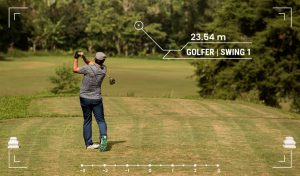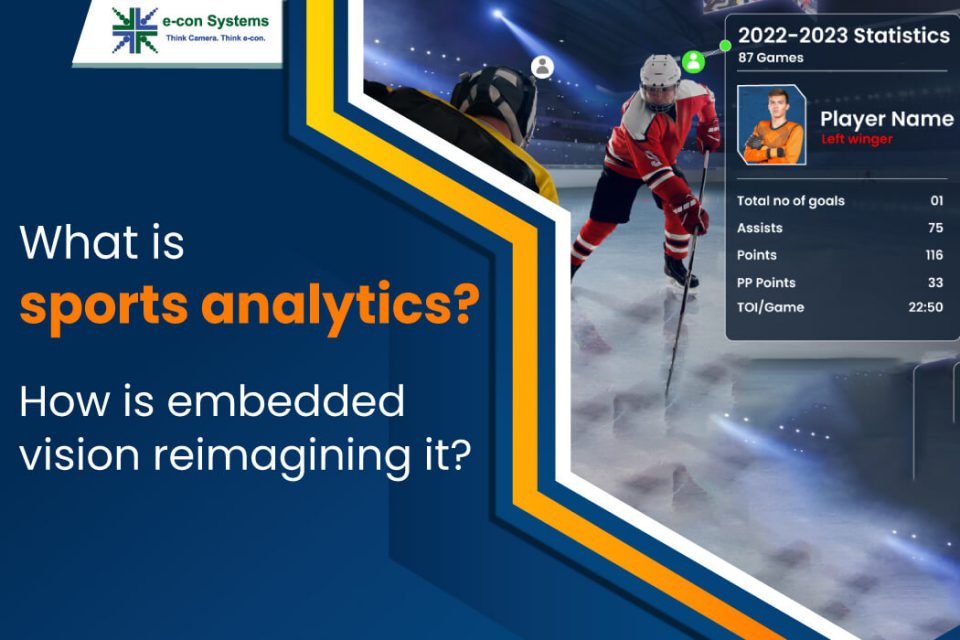Sports analytics is rising in popularity and is becoming a reason for more and more people to be attracted to professional sports and games. According to Grand View Research, the global sports analytics market was valued at USD 889.4 million in 2021. It is expected to expand at a compound annual growth rate (CAGR) of 27.1% from 2022 to 2030. So, there is clearly a huge potential for anyone operating in this market.
And embedded vision is no exception. Embedded vision in sports analytics involves the use of embedded cameras – enabling the collection of image and video data for the analysis of player performance, ball position, player speed, etc. Today, we will dive deep into what sports analytics is, and the role of cameras in redefining the way in which it can help players, coaches, and team managers utilize sports data better.
What is Sports Analytics?
Sports analytics in general refers to the process of analyzing different types of data to assess player performance and the health of the business managing the sports team. There are two types of sports analytics practices:
- On-field analytics: This involves analyzing parameters such as player behavior, skills, performance, etc., on the field. This type of analysis is helpful in player selection, coaching & training, designing a game plan, etc.
- Off-field analytics: Off-field analytics is more to do with the operations side of a sports team where things like ticket sales, team popularity, fan base, etc., are measured.
Sports analytics techniques are practiced with the aim to enable informed decision making while at the same time ensuring that the team grows in terms of winning games & tournaments as well as revenue.
How are sports analytics and embedded vision related?
Modern on-field sports analytics relies on sophisticated technologies like embedded cameras to capture image and video data in order to perform various kinds of athlete and team-level analyses. As simple as this may sound, this requires the camera to be able to accurately capture fast movements of the ball as well as the players.
In most cases, multiple camera modules will have to be used to cover the entire field. The resolution of the camera should be high enough to capture all the necessary details of the scene. In addition, if the device is placed facing a bright light source, an HDR camera might be required.
In essence, camera selection is vital for sports analytics since the data required for it is captured using embedded cameras placed in the sports arena.
Also read: Role of a camera in AI-driven automated sports broadcasting.
Different sports and games where camera-enabled sports analytics is (or can be) used
As mentioned above, sports analytics involving embedded cameras is about capturing and streaming videos of sports matches. It offers multiple advantages such as:
- The ability for the players’ loved ones to watch the matches online, which was earlier possible only for professional matches.
- Coaches and team managers get to analyze player skills and performance automatically and make better judgements for team selection. This can be done at scale for all amateur matches now.
- The entire match can be captured for any future reference purposes.
For these reasons, all the major games and sporting events today either use or at least have experimented with automated sports broadcasting and analytics systems for broadcasting as well as analysis needs.
Today, cameras can help analyze almost all aspects of soccer players – from player speed to the number of passes & dribbles to the distance covered and time with the ball. Cameras can also be used for the purposes of ball tracking and jersey tracking. These data points are key inputs towards making the right on-field decisions for the coach during and between matches.
Basketball
Basketball is one of the games where sports analytics using cameras is gaining momentum fast. Being a sport where player movements are very critical, OEM cameras help to track player moves – thereby feeding in necessary data for the AI-based algorithm to draw a complete picture of individual players’ as well as the team’s performance.
Sports analytics systems in basketball also come with the following features (with the help of smart hoops and cameras):
- Detailed head-to-head analysis
- Personalized training and coaching
- Virtual contests with players worldwide
Baseball
In baseball, sports analytics has been instrumental in gaining key insights into player patterns, especially that of batting. Cameras can be deployed to analyze hitting & swing patterns, assess player strengths & weaknesses, batting power, etc.
Golf
When it comes to golf, the role of cameras revolves mostly around tracking the ball and the club. Cameras help to analyze swing planes, launching angles, and posture & movements of the golfer. This data can then be used to analyze golfer performance and devise coaching plans accordingly.
 Cricket
Cricket
Sports analytics has been in action in cricket for a long time. However, the use of embedded cameras for the purposes of match analysis, pose estimation, player performance analysis, etc., is more of a recent trend.
Ice hockey
In Ice hockey, sports analytics using cameras solves one of the most burning problems – making the right call for challenging scenarios during a match.
Referees and linesmen are often faced with the challenge of not having the right view of the puck in order to make fair decisions. With cameras that come with high frame rates and a wide field of view (that are mostly placed inside the net), live matches can be captured for replays with high levels of detail. This enables the umpires to make the right decisions that are irrefutable during a match.
In short, the adoption of camera technology is for sure on the rise across multiple sports and games. The ability of new-age embedded cameras to swiftly capture player and ball movements has given new dimensions to the space. This combined with advancements in AI (Artificial Intelligence) and ML (Machine Learning) algorithms is carving a new path in the field of sports analytics.
 Sports analytics and automated sports broadcasting – what’s the difference?
Sports analytics and automated sports broadcasting – what’s the difference?
Sports analytics in general refers to performing any kind of analysis on data related to sports and games. As we have already discussed, it can be either on-field or off-field.
However, automated sports broadcasting refers to broadcasting matches (usually amateur matches since they cannot have expensive professional broadcast setups) automatically with the help of embedded cameras. This data is streamed over a network to be telecast on an online streaming platform (just like a professional match).
Now, the key difference between the two in addition to their functioning is that sports analytics can be used in both professional and amateur matches, whereas automated broadcasting systems are usually deployed to capture amateur matches.
Selecting the right camera for sports analytics
Picking, evaluating, and integrating the right camera solution for sports analytics can be complex – if you do not have the right expertise. You need to consider multiple factors such as resolution, multi-camera support, high dynamic range, and more. To learn more about the details you need to keep in mind while selecting a camera for your sports analytics and broadcasting system, please visit the below article:
Choosing the right camera for automated sports broadcasting – everything you need to know
e-con Systems – pioneering embedded vision for automated sports broadcasting and analytics
e-con Systems has been in the embedded cameras business for almost two decades now. Among many other markets the company serves, automated sports broadcasting and analytics has been one of its key focus areas. e-con has already worked with numerous players in the space who are building camera-enabled sports broadcasting systems for a wide variety of games including soccer, baseball, basketball, golf, etc.
Some of the types of camera solutions e-con offers for sports broadcasting and analytics are:
- High resolution (4K and 1080p) cameras
- HDR cameras
- Multi-camera solutions
- Cameras with IP rated enclosures
- Wide FOV (Field Of View) cameras
- Camera modules for popular embedded platforms (including NVIDIA Jetson)
Most of the solutions from e-con come with a combination of 2 or more of the above features. To check out the set of cameras offered by e-con Systems for this application, please visit the sports broadcasting and analytics cameras page. You could also visit the Camera Selector to browse through our entire portfolio of cameras.
e-con’s value additions in sports analytics camera solutions
In addition to offering customized camera solutions to fit your exact end application requirements, two of the areas where e-con stands out are seamless multi-camera integration and image stitching capabilities.
Let us look at both in detail in the upcoming section.
Multi-camera integration and image stitching in sports analytics systems
Before we look at how e-con adds value to building your camera-enabled sports analytics device, we need to understand why multi-cameras are required in it in the first place.
The fact is that a single camera cannot cover the entire FOV of a field or playing arena. So in most cases, you will have to use a minimum of 2 cameras to be able to capture the entire scene. And these cameras will have to operate synchronously to ensure that there is no time lapse between simultaneous image capture using multiple cameras. To learn more about how multi-camera integration works, and the factors you need to consider while embedding multi-cameras into your sports analytics system, we recommend you give the below article a read:
Integrating a synchronized multi-camera system into automated sports broadcasting systems
e-con has worked with many sports analytics device manufacturers by helping them integrate multi-camera solutions smoothly into their systems. We help them with deciding the number of cameras, picking the right sensor, achieving the desired image quality through proper ISP tuning, designing the mechanical enclosure, and more.
One of the key things e-con brings to the table when it comes to multi-camera integration is its stitching expertise. We offer the following types of stitching:
- 180-degree stitching
- 270-degree stitching
- 360-degree stitching
In all the three types of stitching, images from multiple cameras are processed to create the full view of the scene. The proprietary stitching algorithm running on the CUDA GPU stiches together the multiple frames to deliver an RGBA output to create the desired field of view (180, 270, or 360 degree).
Final words
Automated sports broadcasting and analytics is an evolving field. So are its camera requirements. What makes camera integration for this application more complex than what you would think are the nuances involved in it – such as deciding the number of cameras, picking the right lens, preventing lens distortions, quality of stitching, etc. Hence, it is always recommended to take the help of an imaging partner like e-con Systems who has been through the complete journey of camera selection, evaluation, integration, and mass production several times before.
What you get when you work with us is the breadth of experience we have in the domain in addition to the depth of engineering expertise we bring to the table. So, if you are looking for any help in integrating the perfect camera seamlessly into your sports analytics device, please do reach out to us at camerasolutions@e-consystems.com. Let us win together!

Ranjith is a camera solution architect with over 16 years of experience in embedded product development, electronics design, and product solutioning. In e-con Systems, he has been responsible for building 100+ vision solutions for customers spanning multiple areas within retail including self service kiosks, access control systems, smart checkouts and carts, retail monitoring systems, and much more.




